Cannondale Supersix EVO User Manual
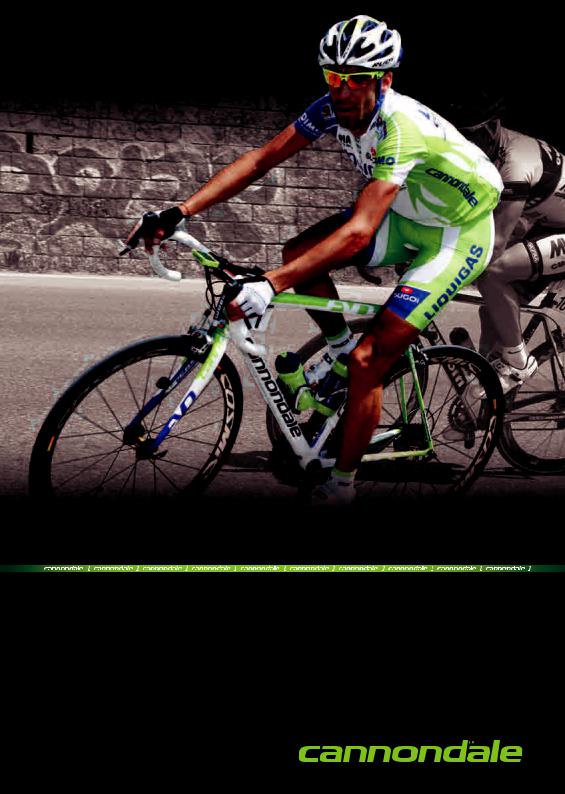
126884 (05/11)
SUPERSIX EVO.
OWNER’S MANUAL SUPPLEMENT.

SAFETY INFORMATION
About This Supplement
Cannondale Owner’s Manual Supplements provide important model specific safety, maintenance, and technical information. They are not replacements for your Cannondale Bicycle Owner’s Manual.
This supplement may be one of several for your bike. Be sure to obtain and read all of them.
If you need a manual or supplement, or have a question about your bike, please contact your Cannondale Dealer immediately, or call us at one of the telephone numbers listed on the back cover of this manual.
You can download Adobe Acrobat PDF versions of any Cannondale Owner’s Manuals or Supplements from our website: http://www.cannondale.com/.
■This manual is not a comprehensive safety or service manual for your bike.
■This manual does not include assembly instructions for your bike.
■All Cannondale bikes must be completely assembled and inspected for proper operation by a Cannondale Dealer before delivery to the owner.

 WARNING
WARNING
This supplement may include procedures beyond the scope of general mechanical aptitude.
Special tools, skills, and knowledge may be required. Improper mechanical work increases the risk of an accident. Any bicycle accident has risk of serious injury, paralysis or death. To minimize risk we strongly recommend that owners always have mechanical work done by an authorized Cannondale retailer.
126884.PDF
Important Composites Message

 WARNING
WARNING
Your bike (frame and components) is made from composite materials also known as “carbon fiber.”
All riders must |
understand |
a fundamental reality |
of composites. |
Composite |
materials constructed of |
carbon fibers are |
strong and light, but when crashed or |
|
overloaded, carbon fibers do not bend, they break.
For your safety, as you own and use the bike, you must follow proper service, maintenance, and inspection of all the composites (frame, stem, fork, handlebar, seat post, etc.) Ask your Cannondale Dealer for help.
We urge you to read PART II, Section D. “Inspect For Safety” in your Cannondale Bicycle Owner’s Manual BEFORE you ride.
YOU CAN BE SEVERELY INJURED, PARALYZED OR KILLED IN AN ACCIDENT IF YOU IGNORE THIS MESSAGE.
Intended Use
ASTM
The intended use of all models is ASTM CONDITION 1, High-
Suitable for Performance Road.
road riding (only)

 WARNING
WARNING
UNDERSTAND YOUR BIKE AND ITS INTENDED USE. USING YOUR BIKE THE WRONG WAY IS DANGEROUS.
Please read your Cannondale Bicycle Owner’s Manual for more information about Intended Use and Conditions 1-5.
05/11 |
1 |
|
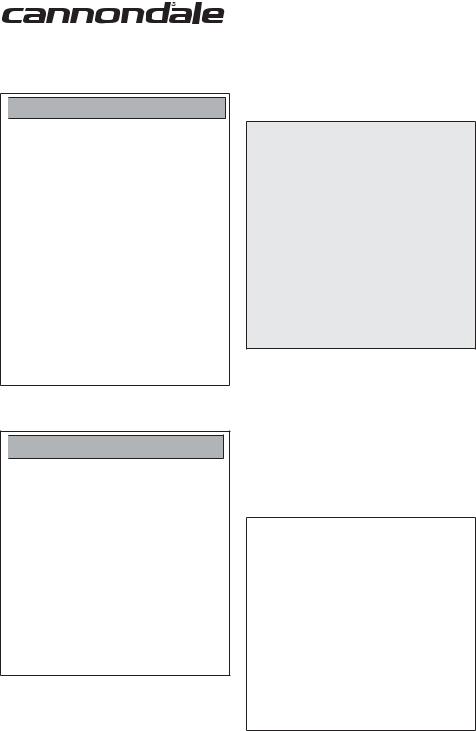
Inspection & Crash Damage Of
Carbon Frames/Forks

 WARNING
WARNING
AFTER A CRASH OR IMPACT:
Inspect frame carefully for damage (See PART II, Section D. Inspect For Safety in your Cannondale Bicycle Owner’s Manual. )
Do not ride your bike if you see any sign of damage, such as broken, splintered, or delaminated carbon fiber.
ANY OF THE FOLLOWING MAY INDICATE A DELAMINATION OR DAMAGE:
■An unusual or strange feel to the frame
■Carbon which has a soft feel or altered shape
■Creaking or other unexplained noises,
■Visible cracks, a white or milky color present in carbon fiber section
Continuing to ride a damaged frame increases the chances of frame failure, with the possibility of injury or death of the rider.
Repainting Or Refinishing

 WARNING
WARNING
Repainting, painting over, retouching, or refinishing your frame or fork can result in severe damage leading to an accident. You can be severely injured, paralyzed or killed.
Refinishing chemicals : Solvents, and strippers can attack, weaken, or destroy the important composite chemical bonds holding your frame together.
Using abrasives or sanding the frame/fork structure, original paint, decals, or coatings through the use of mechanical actions such as plastic or glass bead blasting or other abrasive methods such as sanding or scraping can remove frame material or weaken it.
2
Bicycle Repair / Work Stands
The clamping jaws of a bike stand can generate a crushing force strong enough to seriously damage your frame.
NOTICE
Never place your bike in a bike stand by clamping the frame.
Place your bike in a stand by extending the seat post and positioning the stand clamp on the extended seat post. Don’t extend beyond the MINIMUM INSERT line marked on the seat post.
Since your carbon seat post can also be damaged by clamping force, adjust the stand clamp for the minimum clamping force needed to secure the bike.
Also, before clamping, clean the post and protect the seat post finish with a rag.
If you have an old un-used seat post, use it instead of your regular post to mount your bike in a stand.
Tightening Torques
Correct tightening torque for the fasteners (bolts, screws, nuts) on your bicycle is very important to your safety. Correct tightening torque for the fasteners is also important for the durability and performance of your bicycle. We urge you to have your Dealer correctly torque all fasteners using a torque wrench. If you decide to torque fasteners yourself always use a torque wrench.
Find Tightening Torque Information
The wide range of bicycle models and components used means that a listing of tightening torque would be out of date by the time it was published. Many fasteners should be installed with a thread locking adhesive such as Loctite®.
To determine correct tightening torque and any adhesive application for a fastener we ask you to check:
•Markings on the component. Many components are marked. On-product marking is becoming common.
•Torque specs in the component manufacturers instructions shipped with your bicycle.
•Torque specs listed on the websites of component manufacturers.
•With your Dealer. Dealers have access to current data and have experience with correct torque for most fasteners.
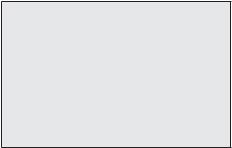
Trainers
If you ride a trainer that requires removal of the front wheel and clamps the fork dropouts: Be sure your fork quick release is tight! Relative movement will wear parts, weaken and damage your bike.
If you ride a trainer that holds the bike up by clamping the rear quick release between two cones: Take off the nice, lightweight quick release that came with your bike. Substitute a heavy, classic all steel quick release and clamp it tight! Relative movement will wear parts, weaken and damage your bike. Note that many modern quick releases will not fit the clamping cones in this kind of trainer because their shapes are incompatible.
Be particularly cautious with a carbon frame or fork. Carbon is relatively soft, not abrasion resistant. If there is any relative movement, carbon will wear quickly.
If you ride a trainer a lot, consider using an old bike: Corrosion from sweat will take it’s toll. Weight is irrelevant. Save wear on your expensive components.
Ask you dealer for help with trainers, the right one and the correct way to use it.
NOTICE
TRAINERS - Improperly mounting a bike in a trainer, or using one that is not compatible with your particular bike frame can cause serious damage.
WATER BOTTLES - An impact, crash, or loose bottle cage can result in damage to your frame.
This kind of damage is not covered by the Cannondale Limited Warranty.
126884.PDF
Water Bottles
Side impacts to a water bottle or cage can result in damage threaded inserts due to the leverage on a very small area. In a crash, certainly the last thing you should be worried about is saving the threaded inserts in your frame. However, when you are storing or transporting your bike, take steps to prevent situations where a water bottle may be hit or bumped by a strong force that would cause damage. Remove bottle and cage when you are packing your bike for travel.
Periodically check the attachment of the bottle cage; tighten the cage bolts if necessary. Don’t ride with a loose bottle cage. Riding with loose cage bolts can produce a rocking motion or vibration of the attached cage. A loose cage will damage the insert and possibly lead to the inserts to pull out. It may be possible to repair a loose insert, or install another insert only if the frame is undamaged. Replacement requires the use of a special tool. If you notice damage to the threaded insert, please ask your Cannondale Dealer for help.
Building Up A Frameset
Before building up a frameset, consult with your Cannondale Dealer and the component manufacturers, and discuss your riding style, ability, weight, and interest in and patience for maintenance.
Make sure the components chosen are compatible with your bike and intended for your weight and riding style.
Generally speaking, lighter weight components have shorter lives. In selecting lightweight components, you are making a trade-off, favoring the higher performance that comes with less weight over longevity. If you choose more lightweight components, you must inspect them more frequently. If you are a heavier rider or have a rough, abusive or “go for it” riding style, buy heavy duty components.
Read and follow the component manufacturers warnings and instructions.
3
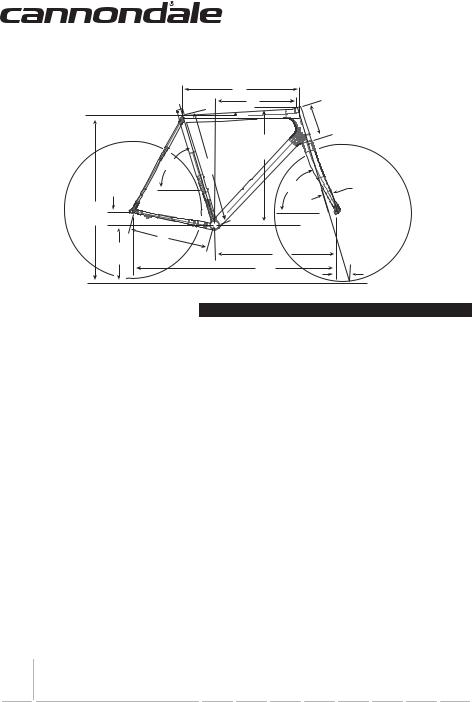
GEOMETRY & SPECIFICATIONS
|
|
|
A |
|
|
|
|
|
|
|
|
|
O |
|
|
|
|
|
|
|
|
|
|
|
M |
|
|
|
|
|
|
|
N |
|
|
|
|
|
|
|
C |
B |
|
|
|
|
|
|
|
|
|
|
|
|
|
|
|
|
|
|
K |
|
|
D |
|
F |
|
|
|
|
J |
|
|
|
|
|
|
|
|
|
E |
|
|
|
|
|
|
|
|
|
G |
|
|
L |
|
|
|
|
|
|
|
|
H |
|
|
|
I |
|
|
|
|
|
|
|
|
|
|
|
|
|
Sizes (cm) |
48 |
50 |
52 |
54 |
56 |
58 |
60 |
63 |
A |
Horizontal Top Tube Length (cm) |
51.5 |
52.5 |
53.5 |
54.5 |
56 |
57.5 |
59 |
60 |
B |
Measured Size (cm)* |
46 |
48 |
50 |
52 |
54 |
56 |
58 |
61 |
C |
Seat Tube Angle (degrees) |
74.5 ° |
74.5 ° |
74 ° |
73.5 ° |
73.5 ° |
73 ° |
72.5 ° |
72 ° |
D |
Head Tube Angle (degrees) |
71.5 ° |
72.0 ° |
72.5 ° |
73 ° |
73 ° |
73.5 ° |
73.5 ° |
73.5 ° |
E |
Chain Stay Length (cm) |
40.5 |
Η |
Η |
Η |
Η |
Η |
40.8 |
40.8 |
F |
Fork Rake (cm) |
4.5 |
Η |
Η |
Η |
Η |
Η |
Η |
Η |
G |
Bottom Bracket Height (cm) |
26.5 |
26.5 |
26.5 |
26.8 |
26.8 |
27 |
27 |
27 |
H |
Wheelbase (cm) |
96.1 |
96.7 |
97.3 |
97.5 |
99.1 |
99.6 |
100.8 |
101.2 |
I |
Trail (cm) |
6.6 |
6.3 |
6.0 |
5.7 |
5.7 |
5.4 |
5.4 |
5.4 |
J |
Standover at Top Tube Midpoint (cm) |
74.2 |
75.5 |
76.7 |
78.8 |
80.4 |
82.5 |
84.3 |
86.9 |
K |
Bottom Bracket Drop (cm) |
7.2 |
7.2 |
7.2 |
6.9 |
6.9 |
6.7 |
6.7 |
6.7 |
L |
Front Center Distance (cm) |
56.3 |
56.9 |
57.5 |
57.6 |
59.1 |
59.7 |
60.6 |
60.9 |
M |
Head Tube Length (cm) |
11 |
11.5 |
12 |
14 |
15.5 |
17.5 |
19.5 |
22 |
N |
Stack (cm)** |
51.3 |
51.9 |
52.6 |
54.4 |
55.8 |
57.7 |
59.6 |
62.0 |
O |
Reach (cm) |
36.8 |
37.6 |
38.4 |
38.4 |
39.5 |
39.9 |
40.2 |
39.9 |
|
Intended Use |
Condition 1, High-Performance Road |
|
|
|
||||
|
Bottom Bracket |
PRESSFIT 30, 68mm |
|
|
|
|
|
||
|
Headset |
Upper 1 1/8” Campagnolo Hiddenset, Lower 1 1/4” |
|
|
|||||
|
Cannondale - KP044/ |
|
|
|
|
|
|||
|
|
|
|
|
|
|
|||
|
Headset Compression Assembly |
Cannondale SI - KP017/ |
|
|
|
|
|
||
|
Seatpost Diameter |
27.2mm |
|
|
|
|
|
|
|
|
Seat Binder |
30.0 mm, Maximum torque: 6.8 Nm, 60.0 In Lbs |
|
|
|||||
|
Dropout Spacing |
Front 100 mm, Rear 130 mm |
|
|
|
|
|||
|
Front Derailleur Clamp Diameter |
|
|
|
|
|
|
|
|
|
Maximum Weight Limit |
Rider (275lbs/125kg), Luggage1 (10lbs/4.5kg), Total(285/129kg) |
|||||||
*The measured size is from the center of the bottom bracket to the top of the top tube, measured along the seat tube axis. All sizes have a slightly sloping top tube.
**Stack is measured vertically from the center of the BB to the top of the head tube, reach is measured horizontally from the center of the BB to the top of the head tube. 1. Seat Bag /Handlebar Bag Only
4
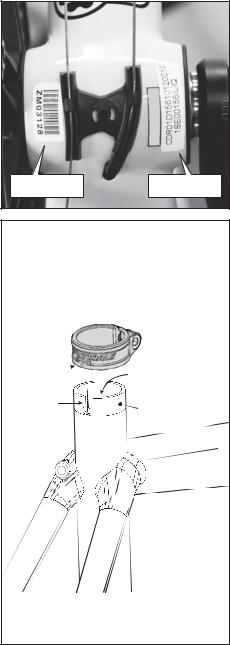
SERIAL NUMBER
The serial number locatded on the bottom bracket. It is a 7-character barcode. Use this serial number to registration your bike. See your Cannondale Bicycle Owner’s Manual for more information on warranty registration.
Other codes on the BB shell are related to production including model year , frame type, frame size, and color coding. The same product code may appear on many bikes and does not uniquely identify your frame.
SEAT POST
Use a high-quality carbon gel to install and maintain the seat post. Cannondale kit KF115/ is a small quantity, enough for two or three applications.
1.Clean the inside of the seat tube. Wipe it out with a dry clean towel.
2.Apply a generous amount carbon gel to the inside of the clean seat tube and to the seat post. A small nylon brush works well for spreading inside the seat tube.
3.Apply small amount of bicycle bearing grease to the area under the binder on the seat tube and reinstall the seat binder.
4.Insert the seat post, set saddle height, and tighten the binder bolt to the specified torque.
TIP: When tightening the seat binder, also check the specified tightening torques of the saddle to seat post clamp bolts.
TIP: Its a good idea to periodically remove the binder bolt, from the binder, clean it threads and lightly grease the threads.
126884.PDF
SERIAL NO. |
PRODUCT CODE |
|
SEAT BINDER |
|
KP196/GRN |
|
KP196/BBQ |
|
5 Nm, 44 InLbs |
Pin |
KF115/ |
align |
CARBON GEL |
Slot |
Light grease |
|
|
|
5 |
